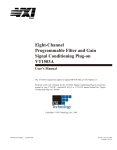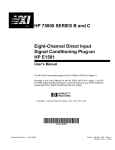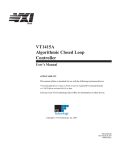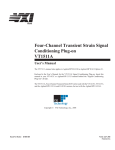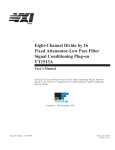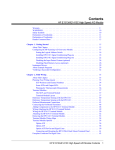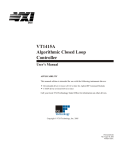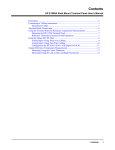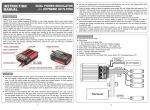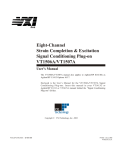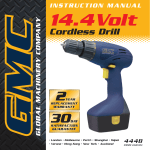Download Corel Ventura - 1516T.CHP
Transcript
HP 75000 SERIES B and C Four-Channel Isolated Fixed Filter and Amplifier Signal Conditioning Plug-on HP E1516A and HP E1517A User’s Manual Enclosed is the User’ s Manual for the HP E1516A and HP E1517A Signal Condit ioning Plug-ons. Insert t his manual in your HP E1413/E1313 or HP E1415 manual behind the “ Signal Conditioning Plug-ons” divider. Copyright © Hewlett-Packard Company, 1996 E1516-90001 Manual Part Number: E1516-90001 Print ed: SEP 1996 Edit ion 1 Print ed in U.S.A. E 0996 HP E1516A and HP E1517A Four-Channel Isolated Fixed Filter and Amplifier Signal Conditioning Plug-on Introduction The HP E1516 and HP E1517 are Signal Conditioning Plug-ons that each provide four channels of galvanically isolated, fixed-gain amplifiers with fixed bandwidth filtering. The difference between the two SCPs is their filter frequency. • True galvanic isolation. DC isolation impedance is at least 108 Ohms Features Set at 0-55°C and 65% relative humidity • Operates with the 4 volt full-scale A/D range only. The gain of 64 • • • • amplification provides 16-bit resolution of differential input voltages from 0 to ±.0625V Differential input impedance is 1 Megohm to channel common Common mode input up to ±60 volts DC or 42 volts peak AC HP E1516A bandwidth is 10 Hz, HP E1517A bandwidth is 100Hz. Open transducer detection is provided. About this Manual This manual shows you how your program can read the SCP’s parameters using SCPI commands, and explains the capabilities of this SCP. Finally, it covers specifications for this SCP. The contents of this manual are: • • • • • Installation . . . . . . . . . . . . . . . . . . . . . . . . . . . . . . . . . . . . . . . Connecting To The Terminal Module . . . . . . . . . . . . . . . . . . Programming With SCPI Commands . . . . . . . . . . . . . . . . . . Programming With Register Commands . . . . . . . . . . . . . . . Specifications . . . . . . . . . . . . . . . . . . . . . . . . . . . . . . . . . . . . 3 4 8 10 11 Installation Installation for this Plug-on is common to several others and is covered in Chapters 1 and 2 of your HP E1413/E1313 or HP E1415 manual. HP E1516/17 Isolated Fixed Filter+Amplifier SCP 3 Connecting To The Terminal Module The SCP connections for the Terminal Modules are shown on the stick-on labels that came with the SCP. Use the appropriate label for the type of Terminal Module you have. The connections and appropriate stickers are as follows: • For HP E1413C and above as well as the HP E1415A Terminal Modules, use the E1516-84304 labels. The connections are shown in Figure 1. • For HP E1313 Terminal Modules, use the E1516-84303 labels. The connections are shown in Figures 2 and 3. • For HP E1413B and below Terminal Modules, see the connections shown in Figure 4. The HP E1516/17’s Connection Formula Even numbered H and L terminals on the Terminal Module connect to the HP E1516/17’s High and Low inputs . The next higher odd numbered H and L terminals become the HP E1516/17’s OT output and C input respectively. The OT output provides Open Transducer detection current for the High input. The C input is the isolated Common terminal and needs to be driven by the test article’s common-mode noise voltage (see Figure 6). G terminals on the Terminal module are not used for the HP E1516/17 Isolated Input SCPs. Figure 1 HP E1516/17 C-Size Terminal Module Connections 4 HP E1516/17 Isolated Fixed Filter+Amplifier SCP Figure 2 HP E1516/17 B-size Terminal Module (Ch 00-31) Figure 3 HP E1516/17 B-size Terminal Module (Ch 32-63) Figure 4 HP E1516/17 Connections with HP E1413B HP E1516/17 Isolated Fixed Filter+Amplifier SCP 5 Recommended Measurement Connections The following illustration shows the recommended method of wiring to the HP E1516/17. Note To provide the specified common mode noise rejection (CMR), the isolated Common terminal (Cnn) must be driven by the common mode voltage source. This is shown in Figure 5. Figure 5 Wiring to the HP E1516/17 Isolated SCP Input Voltage Limits Figure 6 shows the normal mode and common mode voltage limitations. Figure 6 Maximum Operating Voltages 6 HP E1516/17 Isolated Fixed Filter+Amplifier SCP Connections to Detect Open Transducers The HP E1516’s and HP E1517’s Open Transducer Detect is not programmable, but it is configurable at the field wiring connectors. All channels have OTD enabled by default for the LO input. By adding a jumper from the OTnn terminal to the Hnn terminal, OTD is provided for the HI input as well. See Figure 7 for channel OTD configuration and operation. Figure 7 Open Transducer Detection Operation HP E1516/17 Isolated Fixed Filter+Amplifier SCP 7 NOTE When OTD is enabled, the inputs have up to 0.18µA injected into them. Programming With SCPI Commands The SCPI commands shown here are covered in Chapters 3 and 5 of your HP E1413/E1313 manual. This section will relate those commands to the parameter values which are specific to this Plug-on. Fixed Range Only! This isolation SCP must be used on the 4 volt A/D range only. Any readings made through this SCP while on a lower than 4 volt range will return an overload value (±9.9E37). Readings made on the 16 volt range return a meaningless value (but not overload). This means that AUTO range must not be used. When you set the channel’s measurement function using one of the [SENSe:]FUNCtion:… commands, always specify the 4volt range. Some examples: SENS:FUNC:VOLT 4,(@108,110,112,114) volt through all 4 HP E1516 channels at SCP position 1 SENS:FUNC:TEMP TC,K, 4,(@116,118,120,122) Temperature from K type thermocouples SENS:FUNC:RES 4,(@124,126,128,130) Resistance function through channels in SCP position 3 Since the HP E1516/17 has a gain of 64, and must be used on the 4 volt A/D range, it follows that the usable input range is zero to ±0.0625 volts with 16-bit resolution. Checking the ID of the SCP To verify the SCP type(s) installed on the HP E1413/E1313 use the SYSTem:CTYPe? (@<channel>) command. • The channel parameter specifies a single channel in the channel range covered by the SCP of interest. The first channel number for each of the eight SCP positions are; 0,8,16,24,32,40,48, and 56. The value returned for this SCP is: HEWLETT-PACKARD,E1516A 4-Channel Isolated Fixed Gain-Filter SCP,0,0 or HEWLETT-PACKARD,E1517A 4-Channel Isolated Fixed Gain-Filter SCP,0,0 8 HP E1516/17 Isolated Fixed Filter+Amplifier SCP To determine the type of SCP installed on channels 0 through 7 send SYST:CTYP? (@100) enter statement here Querying the Filter Cutoff Frequency query SCP type @ ch 0 While the the HP E1516/17 does not provide programmable cutoff frequency the filter frequency can be queried. The response to this query will always be 10 for the HP E1516, and 100 for the HP E1517. To query any channel for its cutoff frequency use the INPut:FILTer[:LPASs]:FREQuency? (@<channel>) command. The INP:FILT:FREQ? command returns the numeric cutoff value currently set for the channel specified. • The channel parameter must specify a single channel. To query the cutoff frequency of channel 6 send INP:FILT:FREQ? (@106) enter statement here Querying the Filter State query channel 6 While the HP E1516/17 does not allow controlling whether the filters are enabled or disabled, this state can be queried. The response to this query will always be 1. To query any channel to determine if it is enabled or disabled use the INPut:FILTer[:LPASs][:STATe]? (@<channel>) command. The INP:FILT? command returns a 0 if the channel is OFF or a 1 if the channel is ON. • The channel parameter must specify a single channel. To query the filter state of channel 2 send INP:FILT? (@102) query channel 2 enter statement here Querying the Channel Gain While the HP E1516/17’s amplifiers have fixed gain, the channel gain can be queried. The response to this query will always be 64. To query any channel to determine its gain setting use the INPut:GAIN? (@<channel>) command. The INP:GAIN? command returns the current gain value for the specified channel. • The channel parameter must specify a single channel. To query the gain setting of channel 8 send INP:GAIN? (@106) enter statement here query channel 6 HP E1516/17 Isolated Fixed Filter+Amplifier SCP 9 HP E1413/E1313 Register Based Programming The register-based commands shown here are covered in Appendix D of the HP E1413/E1313 manual. You should read that section first to become familiar with accessing registers and executing Register-Based Commands. This section will relate those commands to the parameter values which are specific to this Plug-on. When Register Programming an SCP most communication is through the Signal Conditioning Bus. For that you will use the Register Commands: SCBWRITE <regaddr> <regvalue> and SCBREAD? <regaddr> HP E1516/17 Register Map SCP Model Read (returned value) SCP Register <regaddr> Value HP E1516 only SCP ID (929216) Whole SCP Reg 0 00ppp0000002 HP E1517 only SCP ID (939316) Whole SCP Reg 0 00ppp0000002 Both SCP Gain Scale (XXX216) Whole SCP Reg 1 00ppp0000012 Both Channel Gain ( XXX316=64) Channel Reg 1 01pppccc0012 XX=don’t care ppp=Plug-on # ccc=SCP chan. # Checking ID of SCP To query an SCP for its ID value, write the following value to Parameter Register 1: (SCP number) × 4016 Then write the opcode for SCBREAD? (080016) to the Command Register. The ID value will be returned to the Query Response Register. Checking the SCP’s Gain Scale To read the SCP scale, write the following SCP channel address to Parameter Register 1: (SCP number) × 4016 + 116 Then write the opcode for SCBREAD? (080016) to the Command Register. The channel gain value will be returned to the Query Response Register. Checking a Channel’s Gain To read the gain for an SCP channel, write the following SCP channel address to Parameter Register 1: 20016 + (SCP number) × 4016 + (SCP channel number) × 816 + 116 Then write the opcode for SCBREAD? (080016) to the Command Register. The channel gain value will be returned to the Query Response Register. 10 HP E1516/17 Isolated Fixed Filter+Amplifier SCP Specifications These specifications for the HP E1516/17 reflect the combined performance of the HP E1413/E1313 or HP E1415 and the HP E1516/17 Signal Conditioning Plug-on. These specifications are not to be added to those presented in the HP E1413/E1313 or HP E1415 User’s Manual. General Specifications Measurement ranges DC Volts 0 - ±0.0625V FS Temperature Thermocouples - -200 to +1700 °C Operating: < ±60 VDC, 42V peak AC Maximum input voltage (Normal mode plus common mode) Operating: < ±60 VDC 42V peak AC Maximum common mode voltage Normal mode rejection Common mode rejection Input impedance Maximum tare cal offset HP E1516A @ 10Hz -6dB, @ 60Hz >-25dB HP E1517A @ 100Hz -6dB, @ 200Hz >-15dB HP E1516A DC @ 60V DC - 1KHz @ 42V peak DC - 10KHz @ 10V peak DC - 100KHz @ 2V peak -145dB -120dB -120dB -110dB HP E1517A DC @ 60V DC - 1KHz @ 42V peak DC - 10KHz @ 10V peak DC - 100KHz @ 2V peak -145dB -105dB -105dB -105dB 1 Mohm ±2% (each differential input to isolated Common) 0.0122 Volts HP E1516/17 Isolated Fixed Filter+Amplifier SCP 11 (90 days) 23°C ±1°C (with *CAL? done after 1 hr warm up and CAL:ZERO? within 5 min.). If autoranging is ON, add ±.02% FS to accuracy specifications. For E1313, multiply Noise Spec. by 1.4. Measurement accuracy DC Volts Gain 64 Range ±V FS Linearity % of reading Offset Error µV (10Hz) Noise µV 3 sigma Noise µV* 3 sigma HP E1516A HP E1517A .0625 .0625 0.015 0.015 3.8 3.8 10 12.5 8 10 * HP E1413/1313 [SENS:]FILT:LPAS:STATE ON (max scan rate - 100 rdgs/sec/channel) Temperature Coefficients: Gain; 10ppm/°C. Offset; (0 - 40°C) .14µV/°C, (40 - 55°C) .8µV/°C Measurement accuracy Temperature (90 days) 23°C ±1°C (with *CAL? done after 1 hr warm up and CAL:ZERO? within 5 min.). If autoranging is ON, add ±.02% FS to accuracy specifications. (simplified specifications, see temperature accuracy graphs in HP E1413/E1313 manual for details) The temperature accuracy specifications include instrument and firmware linearization errors. The linearization algorithm used is based on the IPTS-68(78) standard transducer curves. Add your transducer accuracy to determine total measurement error. Thermocouples Type E Type EEXtended Type J Type K Type N Type R 12 Model -200 to 0 °C 0 to 200 °C 200 to 600 °C 600 to 1000 °C HP E1516A HP E1517A 1.44°C 1.51°C 0.23°C 0.27°C 0.16°C 0.19°C 0.19°C 0.21°C Model -200 to 0 °C 0 to 200 °C 200 to 800 °C 800 to 1000 °C HP E1516A HP E1517A 12.4°C 12.5°C 0.38°C 0.44°C 0.20°C 0.25°C 0.19°C 0.25°C Model -200 to 0 °C 0 to 200 °C 200 to 760 °C 760 to 1200 °C HP E1516A HP E1517A 1.78°C 1.85°C 0.26°C 0.30°C 0.24°C 0.27°C 0.25°C 0.29°C Model -200 to 0 °C 0 to 375 °C 375 to 800 °C 800 to 1370°C HP E1516A HP E1517A 3.04°C 3.23°C 0.33°C 0.43°C 0.29°C 0.34°C 0.41°C 0.46°C Model -200 to 0 °C 0 to 200 °C 200 to 800 °C 800 to 1300 °C HP E1516A HP E1517A 4.88°C 5.01°C 0.65°C 0.72°C 0.43°C 0.48°C 0.36°C 0.42°C Model 0 to 100 °C 100 to 200 °C HP E1516A HP E1517A 2.74°C 3.15°C 1.71°C 2.03°C HP E1516/17 Isolated Fixed Filter+Amplifier SCP 200 to 1200 °C 1200 to 1750 °C 1.28°C 1.54°C 0.80°C 0.97°C (simplified specifications, see temperature accuracy graphs in HP E1413/E1313 manual for details) Measurement accuracy Temperature (cont.) Thermocouples (cont.) Type S Type T Model 0 to 100 °C 100 to 200 °C 200 to 800 °C 800 to 1750 °C HP E1516A HP E1517A 4.16°C 4.62°C 3.38°C 2.77°C 1.54°C 1.87°C 1.04°C 1.30°C Model -200 to -100°C -100 to 0 °C 0 to 200 °C 200 to 400 °C HP E1516A HP E1517A 1.85°C 1.97°C 0.51°C 0.58°C 0.32°C 0.37°C 0.22°C 0.25°C HP E1516/17 Isolated Fixed Filter+Amplifier SCP 13 Notes 14 HP E1516/17 Isolated Fixed Filter+Amplifier SCP
















